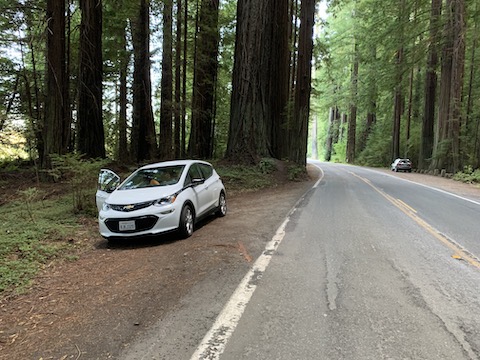
While the Chevy Bolt is an excellent vehicle in most respects, the truth of the matter is that it was not particularly designed for easy, quick long-distance travel. By long-distance trips, I mean those going more than 200 miles (less than that can usually be done without recharging). But for longer trips, you will usually need to rely on DC Fast Charging – a $750 option which Chevy’s programming ensures is rarely all that ‘fast’, compared to most EVs. All that said, long trips can be done – they simply require planning and a bit more time.
1) Charge Beforehand. This is pretty obvious, but there’s no reason to start with less than a full charge. This ensures that you can get 180-200 miles before needing to recharge.
2) Charge Overnight. If you are doing a multi-day trip, try to plan your stops in or near places with L2 charging (200V, 32A). The Bolt will fully charge in ~9 hours from a good L2 charger, so you can arrive close to empty and expect to be fully charged by morning.
Many hotels have L2 chargers (J-1772) and charging is free with the room. Some have Tesla Destination chargers, which require a $200 adapter to use with the Bolt (IMO a good investment if you travel a lot). If there is an L2 charger within walking distance of the hotel, that will work fine too. In a pinch you can also use a regular wall outlet although that’s only good for ~25% charge overnight.
3) Choose fast charging locations carefully. Unfortunately DCFC stations are not yet as widespread or as reliable as one might like. On Plugshare you can see where they are and whether they’ve recently been used successfully. Electrify America and EvGo stations are faster, cheaper and typically more reliable than the alternatives (particularly EA). If at all possible, avoid 25kW stations. They are slow.
4) Space out your stops. Because Chevy is very conservative with the Bolt’s fast charging speeds, the battery charges fastest between 0-55%, slows again at 67% and becomes very slow after 82%. If possible, arriving with less than 20% charge and charging to 67% will save time and money. Conservatively, charging from 17-67% takes ~45 minutes (and adds 120 miles of range). Obviously this isn’t possible for all routes. One tool to help plan this is A Better Route Planner.
5) Choose routes with multiple charging options. As noted above, DCFCs are sometimes unreliable. Also, weather conditions (e.g. headwinds) can impact efficiency. While it’s never happened to me, you don’t want to arrive at a station nearly empty and find that it’s not working (or worse yet, not be able to arrive in the first place). Picking a route with DCFCs at least every 50 miles means you will usually have options. If that’s not possible, make sure there are L2 chargers within driving distance of the DCFCs. They’re slow, but if the DCFC does not work, they will still give you 25 miles/hour.
6) Minimize heater use. It has a pretty big impact on energy use. If you have heated seats, they’re much more effective. There are accessory seat heaters you can get too.
7) Don’t go too fast. I find 55MPH with cruise control to be a good compromise. It is true that even at 80MPH, the car typically charges faster than it discharges, so overall time spent traveling may go down a bit, but you will need to make more stops and spend more time charging (and less time driving). It’s also more expensive.
8) Leave a buffer. The on-board range estimate is typically not bad, but don’t depend on it being spot on. I’d recommend at least a 25-30 mile buffer meaning your destination should be at least 25-30 miles closer than the current range estimate. Getting too low on charge spurs range anxiety and makes the trip much less relaxed. Charging more often may take a little more time, but it’s worth it for peace of mind.
How does this work in practice? Well I did a trip from San Mateo to Los Angeles over Thanksgiving, a distance of roughly 420 miles almost all on US 101. We started fully-charged, kept to ~55MPH, and used the heater occasionally (it was cold enough that there was hail outside).
- 0 miles, 100%, 10:00AM – Leave San Mateo
- 80 miles, 60%, 11:30AM – Arrive Prunedale Recargo DCFC
- 80 miles, 80%, 11:50AM – Leave Prunedale
- 215 miles, 25%, 2:15PM – Arrive San Luis Obispo EvGo DCFC
- 215 miles, 65%, 2:50PM – Leave San Luis Obispo
- 350 miles, 15%, 5:20PM – Arrive Ventura EvGo DCFC
- 350 miles, 65%, 6:00PM – Leave Ventura
- 420 miles, 35%, 7:30PM – Arrive Los Angeles
So overall, the trip took 9h30, of which 1h35 were spent charging, at a cost of $23. Google’s estimate is 6h30, so we lost some time just by dint of driving slower. Note that I wasn’t able to space my stops out optimally because there were no reliable, >50kW stations at the time between Prunedale and San Luis Obispo (there is now an EA station in Paso Robles). I was also charged longer than necessary in Ventura because I took the opportunity to do a bit of shopping.
